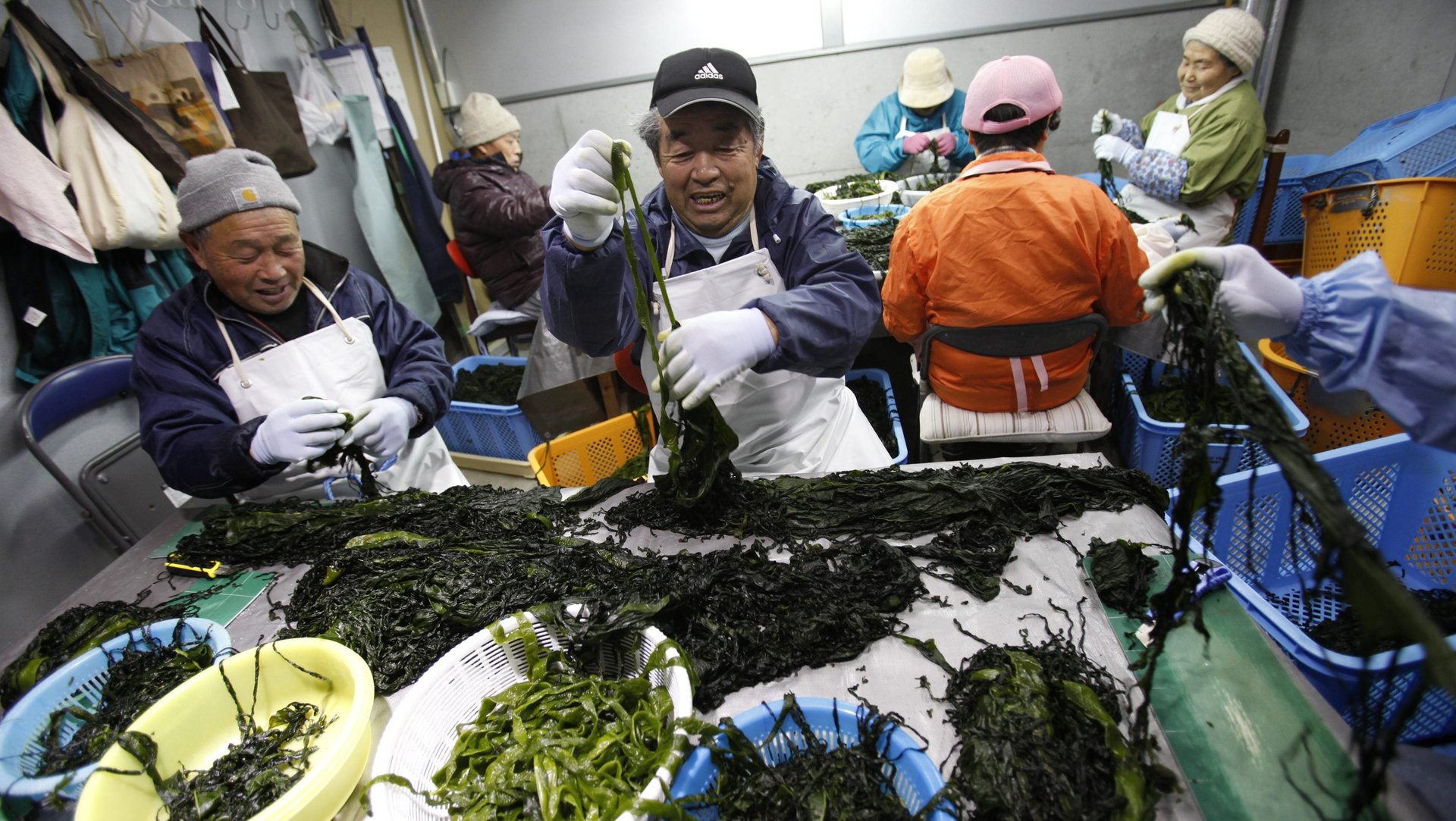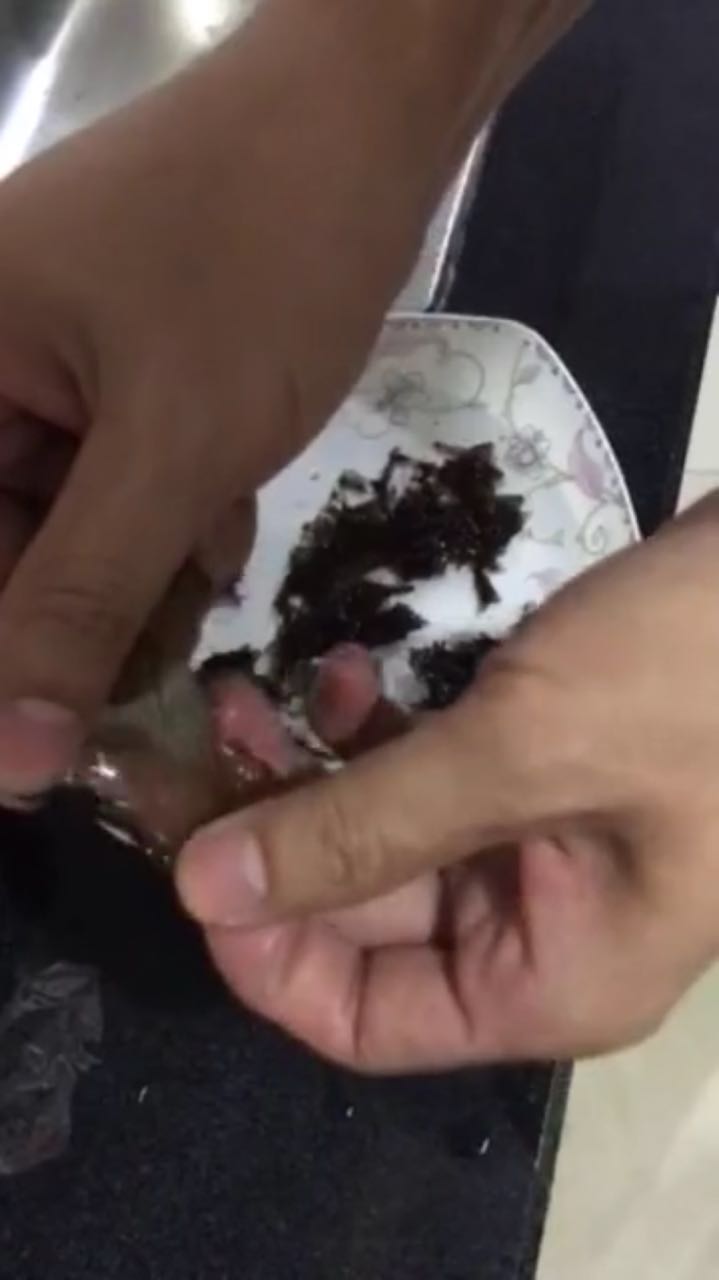In China, consumers have to be on guard not just against fake food, but also fake news about food
“How could people ever believe that seaweed could be made out of plastic?” long-time seaweed entrepreneur Zeng Huaqing asked himself on Feb. 17, after one of his clients sent him a 10-second long video on WeChat that appeared to show a home cook finding a piece of thin black plastic in a bag of seaweed that bore Zeng’s company name. Zeng reassured the client and put the video out of his mind—but not for long.


“How could people ever believe that seaweed could be made out of plastic?” long-time seaweed entrepreneur Zeng Huaqing asked himself on Feb. 17, after one of his clients sent him a 10-second long video on WeChat that appeared to show a home cook finding a piece of thin black plastic in a bag of seaweed that bore Zeng’s company name. Zeng reassured the client and put the video out of his mind—but not for long.
By the following day, said 35-year-old Zeng, who has been running a wholesale seaweed business for 17 years, the clip he had dismissed as ”a nonsense video” had morphed into about 20 different versions and racked up more than two million views on on Weibo, China’s most popular social media platform with 313 million monthly active users. Soon enough, he said, the wholesale price of seaweed, dropped by more than 50% in Jinjiang — the southern Chinese coastal city that Zeng’s company is based in, and where 70% of China’s seaweed products come from.
The seaweed video is just one of many fake food stories going viral in China, where fears about the safety of food products made in China have been deep-seated in the wake of major cases of food contamination, and constant exposés of fake food. But now, some of the exposés too are turning out to be fake, creating an ever more uncertain climate for consumers, and the manufacturers who cater to them.
“It’s natural that whatever involves health and security will concern the public the most, but what makes China unique is that we have a lot of food security issues,” says Zhu Ying, director of the journalism school at Guangdong University of Foreign Studies, “so food rumors spread quickly every time.”
Destructive to customers, companies, and the industry

It isn’t just Zeng who has dismissed the seaweed videos as a form of fake news. Chinese food safety officials have strongly countered the allegations contained in the videos, whose source hasn’t been determined. In the video, the speaker soaks a piece of dry seaweed, usually prepared by boiling in soup, and then stretches it to show how it’s translucent and doesn’t tear, like thin plastic.
“In fact, the semi-transparent look is how seaweed is supposed to be after drained in cold water, and the temperature of the water used to drain the seaweed might not be high enough, so the seaweed can’t be torn apart,” wrote (link in Chinese) Ruan Guangfeng, director of communication and research at China Food Information Center, a nonprofit organization founded in 2014 with the approval of the Ministry of Civil Affairs.
Later, Bi Jingquan, head of the China Food and Drug Administration, asked, “Will you take a second bite if you can already tell the seaweed’s made of plastic in the first bite?” at a press conference on Feb. 27 (link in Chinese), adding that “plastic seaweed is a rumor” and that “whoever creates a rumor” could face jail time.
But the damage was already done. “The wholesale price dropped from 80,000 yuan ($11,600) per metric ton to around 40,000 yuan ($5,800) in a week,” says Zeng, “And we sell some 20,000 tons (22,000 US tons) of seaweed every year in Jinjiang.”
Zeng’s company, Fuguangjia Food, conducted a survey at local market with among 500 respondents—mostly housewives and other major customers of seaweed products—in early March. Citing the videos “more than 75% of the respondents told us they won’t buy any seaweed products in the near term,” said Zeng.
Ayibo Food, a nearly three-decade-old local seaweed product company, confirmed that prices tanked. “Many stores took down our company’s products and I received a blackmail call that asked for as high as 80,000 yuan on Feb. 20,” says Li Xiaojiang, manager of the company, which sees an annual production value of 400 million yuan ($58 million) (link in Chinese). The company identified at least seven versions of the “plastic seaweed” videos that displayed the company’s products. “I was too angry to even tape the phone calls,” Li said.
The crisis hit so hard that Li is seriously worried about 2017. “Don’t even think about making profits this year,” he said.
“This is detrimental to us,” added Zeng, “These videos cost us millions of yuan, whether the rumor spreaders intended to do it or not.”
A market hungry for food news
The plastic seaweed rumors, however, are just a small portion of the fake news focused on food that is spreading across the Chinese internet every year, according to researchers. Food rumors is near the top among news topics that are the most widely spread and hardest to contain, they say.
From April 2015 to March 2016, over 15% of the 2,175 rumors that were widely read and reported on WeChat were linked to its combined food-and-health news category, making the section the most frequent source of unsubstantiated or exaggerated information on the app (link in Chinese) after politics, according to a paper published in April by Sun Yat-sen University’s Big Data and Communication Laboratory.
An article stating “crayfish is filled with parasites” was shared and viewed over 54 million times on WeChat last year, the Chinese Institute of Food Science and Technology (CIFST), a Beijing-based association with membership from industry, academia, and government, told an annual food conference (link in Chinese) in January. “The parasite claim was exaggerated, although it’s not encouraged to eat shrimps or crabs raw, but cooked crayfish is safe to eat,” the state-run People’s Daily reported, quoting experts from the meeting. The crayfish is a small red crustacean that has found its way to Chinese tables in recent years.
At the same conference, CIFST identified other fake food news that it said spread widely in 2016, including “seedless grapes are cultivated with birth control medicines,” “a 20-year-old man was infected H7N9 and died after eating cherries in China’s northern province Shandong,” and “pork was contaminated with parasites” (links in Chinese). CIFST says none of these claims could be substantiated; the pork parasite, for example, turned out to be a tendon—a flexible and inelastic whitish cord of tissue attaching muscle to bone.
Many academics, government departments and food companies have made clarifications to ease food-related concerns. The problem, though, is that in the past, companies and officials haven’t always been completely honest with consumers.
“Why food rumors have a market”
The utter lack of confidence in official pronouncements on food in China has its roots in the country’s notorious milk-powder scandal in 2008, argued commentator Hu Yinbin in “Why food rumors have a market (link in Chinese)” published in Beijing Youth Daily, a state-owned newspaper, last June.
Almost 300,000 babies suffered from urinary problems and at least six infants died after consuming milk powder adulterated with melamine, a chemical compound that is used in electrical manufacture, and can cause kidney stones if consumed by humans. China executed two diary farmers and jailed 19 for endangering public safety the following year.
“Public confidence hasn’t made any progress since the melamine milk scandal,” wrote Hu, “you can tell by people’s craze for Hong Kong milk powder.” Enterprising folks began crossing the border to stock up on the product to sell it back home, causing at times a shortage of milk powder in areas of Hong Kong bordering mainland China.
In the milk scandals, Chinese investigators said that Sanlu Group, which was majority-controlled by a provincial city government, had been alerted by consumer complaints to problems with its baby formula product months before it informed authorities (paywall). Investigators also said that local authorities of China’s northern province Hebei, where Sanlu was based, knew about the tainted milk in August, about a month before Sanlu finally announced a product recall.
After the milk scandal, China passed a new law on additives, and beefed up government coordination on food safety, including by restructuring its agency that administers food and drug safety. The agency in 2015 established an association to refute rumors (link in Chinese) that works with other government organs such as Ministry of Agriculture and state new agency Xinhua.
“We have noticed that food rumors are affecting people’s judgement on the food security situation,” China’s Food and Drug Administration(CFDA) said, attributing the rise of these rumors to “the social structure,” as well as in some case to “vicious groups” who spread rumors against rivals. On the information front, CFDA says it has established social media platforms to provide the public with weekly updates on food sample results. In regard to food safety, it said it has taken several steps, including increased sampling and tightening regulations relating to pesticide residues.
Incidents still occur that sow fresh doubt about authorities’ intentions.
Earlier this month, in an annual consumer-protection program that often publicizes infractions attributed to foreign companies, China’s state-owned CCTV channel alleged that Japanese retailer Muji was selling contaminated food from areas affected by radiation after the flooding of the Fukushima nuclear plant in 2011. Muji, however, released a statement citing its China-approved import certifications to refute (link in Chinese) CCTV’s report. CCTV didn’t immediately respond to an email query about the program.
But Muji’s statement didn’t convince everyone. “I don’t care if this is real and I won’t buy your food products anyways,”commented Weibo user Professor Pear (link in Chinese) under Muji’s statement, “No matter this is real or not, I have to be careful, after all.”
Even if news later turns out to be fake “there’s nothing to lose by believing it,” says Yun Wuxin, a Chinese food industry observer and member of the China-based nonprofit organization Songshuhui Association of Science Communicators. And, he added, “There’s no simple way to tell if the news or the [food] companies’ announcements are true.”
To combat the lack of transparency, food producers say they are realizing that they have to rebuild confidence by creating more channels for customers to talk to companies when they need. “In the past, we only know how to sell seaweed, but this hit has made us realize that sometimes it’s more important to educate the public,” said Zeng, “And more importantly, build up the trust.”
This article has been updated April 3 with comments from China’s Food and Drug Administration.